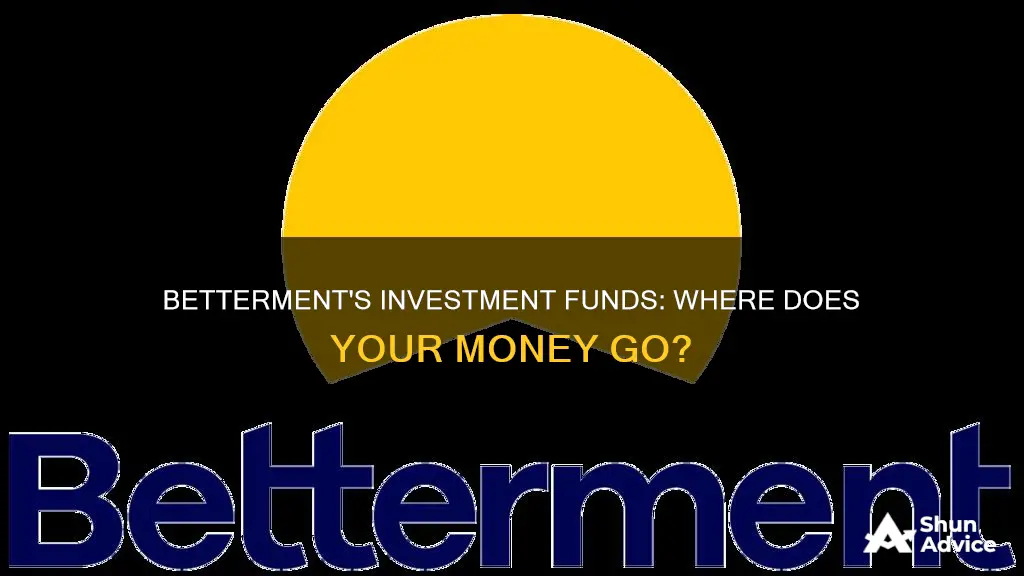
Betterment offers a range of investment options for individuals looking to build wealth over the long term. The company's curated portfolios are well-diversified and feature a broad collection of exchange-traded funds (ETFs) made up of thousands of stocks and bonds from around the world. Betterment's investment strategy focuses on low-cost, passive investments that seek to match the market's performance, and the company utilizes automated tax strategies to help minimize the tax impact on returns. In addition to its core portfolio, Betterment also offers socially responsible investment options, innovative technology portfolios, and flexible portfolios for experienced investors seeking more control.
| Characteristics | Values |
|---|---|
| Portfolio type | Core portfolio, 401(k) plans, flexible portfolio |
| Investment type | Exchange-traded funds (ETFs), stocks and bonds, cash, crypto |
| Investment focus | Long-term, low-cost, diversified, tax-efficiency |
| Investment strategy | Passive investing, automated tax strategies, rebalancing |
| Number of allocation options | 101 |
| Stock-to-bond ratio | 90% stock, 10% bond (can vary depending on client goals) |
| Bond type | National municipal bond ETF, state-specific municipal bond ETFs (for CA and NY residents) |
What You'll Learn

Exchange-traded funds (ETFs)
Betterment's Core Portfolio is a low-cost investment option designed for long-term returns while reducing risk through diversification. It features a broad collection of exchange-traded funds (ETFs) made up of thousands of stocks and bonds from around the world. This portfolio has 101 different allocation options, ranging from 0% bonds to 100% stocks, with the default being a 90% stock and 10% bond allocation. The default portfolio has been selected to showcase the holdings, and different allocations will result in varying weights of each asset class.
ETFs are securities that track an index, a commodity, or a basket of assets like an index fund, but they trade like stocks on an exchange. Betterment utilizes ETFs in both stock and bond portfolios due to their low management fees and tax efficiency. The ETFs in the Core Portfolio include a national municipal bond ETF, as well as state-specific municipal bond ETFs for California and New York residents.
The Core Portfolio is designed for passive investing, aiming to match the market's performance. While fluctuations in the market are normal and challenging to predict in the short term, Betterment's investment strategy seeks to optimize returns while minimizing risk through diversification.
Betterment also offers a Flexible Portfolio option for experienced investors who want more control. This option allows investors to adjust individual asset class weights based on their preferences.
High-Speed Trading Funds: Strategies for Smart Investing
You may want to see also

Stocks and bonds
Betterment offers a range of investment options, including stocks and bonds, which are well-diversified and built for long-term investing. The company's Core Portfolio is a low-cost option designed to generate long-term returns while reducing risk through diversification. It features a broad collection of exchange-traded funds (ETFs) comprising thousands of stocks and bonds from around the world.
The Core Portfolio has 101 different allocation options, ranging from 0% bonds to 100% stocks. The default portfolio is allocated 90% in stocks and 10% in bonds. However, Betterment may recommend a different allocation based on various goal inputs tailored to each client, such as the time horizon for their goals. For example, a short-term goal may have a more conservative portfolio with lower expected returns and less volatility, while a long-term goal may have a more aggressive portfolio with higher expected long-term returns and higher volatility.
The stocks and bonds in the Core Portfolio provide exposure to companies from various sectors and regions, offering investors a globally diversified portfolio. The ETFs in the portfolio are selected for their low management fees and tax efficiency. Additionally, Betterment employs automated and optimized tax strategies to help minimize the tax impact on returns, allowing investors to keep more money in their portfolios.
For investors seeking more control over their portfolios, Betterment offers the option to customize their portfolios. Experienced investors can adjust individual asset class weights based on their preferences. This flexibility allows investors to align their portfolios with their specific financial goals and risk tolerances.
Hedge Funds: Investment Advisors or Something Different?
You may want to see also

Socially responsible stocks and bonds
Betterment offers three Socially Responsible Investing (SRI) portfolios: a SRI Broad Impact portfolio, a Climate Impact portfolio, and a Social Impact portfolio. The SRI portfolios are built on the idea of investing in companies that are striving to create a positive social and environmental impact on the world.
The Broad Impact portfolio is a popular choice for anyone interested in overall change. It increases your exposure to investments that consider all three environmental, social, and governance pillars. The portfolio uses the Core portfolio as a foundation and swaps in SRI alternatives in four classes: US Stocks, Emerging Market Stocks, Developed Market Stocks, US High-Quality Bonds, and US Corporate Bonds.
The Climate Impact portfolio is designed for the eco-conscious investor. This portfolio includes investments that seek to lower carbon emissions and fund green projects. It divests from owners of fossil fuel reserves and includes a global green bond fund.
The Social Impact portfolio is designed for the equality-minded investor. It uses the Broad Impact portfolio as a foundation and adds two funds: one focused on gender diversity ($SHE) and another on minority empowerment ($NACP).
All three SRI portfolios are diversified, cost-efficient, and built for the long term. They are designed to make it easy for investors to support companies that share their values, such as funding green projects and promoting gender diversity, while investing in cost-effective ETFs.
When choosing an SRI portfolio, investors will receive or select an allocation of stocks and bonds. A higher percentage of bonds will result in a lower percentage of the portfolio being allocated to socially responsible ETFs.
Invest in Tata Retirement Savings Fund: A Comprehensive Guide
You may want to see also

Goldman Sachs Smart Beta
The Goldman Sachs Smart Beta portfolio strategy is designed for investors who want to take on more systematic risk at a given allocation between stocks and bonds than is possible with a comparable allocation in the standard, default Betterment portfolio strategy. The smart beta portfolio incorporates certain stock exchange-traded funds (ETFs) that do not weight their holdings based solely on market capitalization ("smart beta equity ETFs"). These ETFs make rules-based adjustments to the market weights of their holdings based on four factors: good value, high quality, low volatility, and strong momentum. These factors have been identified in academic research as persistent drivers of investment returns in stocks.
The Goldman Sachs Smart Beta portfolio strategy targets companies that have the potential to outperform the broader market over the long term. These companies are characterized as being cheap relative to their accounting value, sustainably profitable over time, exhibiting relatively low volatility in returns, and having been trending strongly upward in price. This portfolio strategy maintains broad diversification and can lead to higher potential long-term gains, but it also exposes investors to a greater risk of periodic losses.
The smart beta equity ETFs in the Goldman Sachs Smart Beta portfolio make rules-based adjustments to the market weights of their holdings based on the four factors mentioned earlier. These factors are measured as follows: good value is measured by price relative to fundamentals such as book value and free cash flow; high quality is measured by profitability; low volatility is measured by the standard deviation of returns; and strong momentum is measured by a relatively strong upward trend in price in recent times.
In addition to smart beta equity ETFs, the Goldman Sachs Smart Beta portfolio also incorporates certain fixed-income ETFs that do not weight their holdings solely based on market capitalization ("smart beta fixed-income ETFs"). These smart beta fixed-income ETFs use liquidity, technical, and fundamental screening criteria to minimize exposure to factors historically associated with volatility and underperformance. The smart beta portfolio may, at times, allocate more of its bond holdings to high-yield and longer-duration bonds, which may be riskier than the bonds held in Betterment's core portfolio.
The Goldman Sachs Smart Beta portfolio strategy is designed by Goldman Sachs Asset Management and is generally comprised of ETFs managed by Goldman Sachs, but it may also include ETFs managed by other fund managers. This portfolio strategy has 101 different allocation options, ranging from 0% bonds to 100% stocks. The specific allocation of stocks and bonds within the portfolio is determined by Goldman Sachs, who may change the relative weights of sub-asset classes within a particular allocation based on their evaluation of market conditions.
Vanguard Star Fund: Smart Investment Strategy or Risky Move?
You may want to see also

Innovative Technology
Betterment's Innovative Technology portfolio is well-diversified and focused on high-growth potential companies. It includes investments in clean energy, semiconductors, robotics, virtual reality, blockchain, and nanotechnology. This portfolio is designed for investors who are comfortable with higher exposure to risk and are seeking long-term growth.
The Innovative Technology portfolio is ideal for those who want to invest in cutting-edge industries that are shaping the future. Clean energy, for example, is a sector that focuses on renewable and sustainable sources of energy, such as solar, wind, and hydroelectric power. Semiconductors are essential components in electronic devices, powering everything from smartphones to electric vehicles. Robotics is another key area of investment, including companies that develop and manufacture advanced machines that can perform complex tasks with precision and efficiency.
Virtual reality is a rapidly growing field, with applications in gaming, entertainment, and even training and education. Blockchain technology, known for its secure and transparent nature, is revolutionizing transactions and data storage, and has the potential to disrupt multiple industries. Nanotechnology, the manipulation of matter at an incredibly small scale, has far-reaching implications in fields such as medicine, electronics, and materials science.
By investing in the Innovative Technology portfolio, individuals can gain exposure to these dynamic and transformative industries. It offers the potential for significant growth, but it's important to remember that higher returns often come with higher risk. Therefore, this portfolio is more suitable for investors with a higher risk tolerance and a long-term investment horizon.
Medallion Hedge Fund: A Guide to Investing Wisely
You may want to see also
Frequently asked questions
Unlike a traditional retirement plan, Betterment doesn't make you choose your own funds. Instead, they recommend a basket of funds that's diversified to seek performance without unnecessary risks.
Betterment uses exchange-traded funds (ETFs) in both their stock and bond portfolios because of the low management fees and tax efficiency they offer.
An exchange-traded fund (ETF) is a security that tracks an index, a commodity, or a basket of assets like a stock on an exchange.
Betterment portfolios are well-diversified, low-cost, and built for long-term investing. They feature a broad collection of ETFs made of thousands of stocks and bonds from around the world.
Like all market investments, the securities you own are subject to market risk. Fluctuations in the market are normal and hard to predict over the short term.







